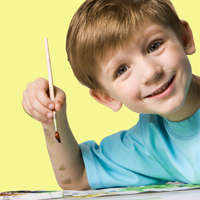| Art Education Research

Supercharge Your Child’s IQ
Dr. Robert Sternberg, Dean of Arts and Sciences at Tufts University, specializes in determining what makes
people successful in life. Through his research, he has determined that Imagination and Creativity
are just as important as Intelligence.
Today our schools are placing a great deal of emphasis on test taking, grades and the classic IQ: Intelligence
Quotient. Parents, wanting their children to be successful in life, often worry about how these things
will affect their children’s futures. In Dr. Sternberg’s ground breaking research, he reveals that creativity
is just as important for a child to be academically successful. In fact, he found that being a creative
individual substantially improves a young person’s college success.
“Intelligence is certainly important, but it’s only part of the equation,” Dr. Sternberg says. “Intelligence
and imagination are both essential to a child’s success now and in the future.” Further he adds, “Parents
(and teachers) should also be thinking about what they can do to boost children’s imaginations. One of
the best things they can do is nurture creativity from an early age.”
So what can parents and teachers do to supercharge imagination and creativity through the arts?
- Provide opportunities for children to be creative. Supplement arts related activities in
school with classes like Abrakadoodle® and activities at home. The average public
elementary school provides its students only 26 hours of visual arts instruction a year.*
- Ask questions and present challenges – Ask “What if the sun came up at night?” and
“What would it be like if … you lived underground like a mole?”
- Generate ideas – Provide art supplies and encourage kids to record their ideas,
anywhere and anytime.
- Explore other points of view – Challenge children to come up with different endings
to stories or to see an experience through someone else’s eyes.
- Encourage collaboration – Try group projects in which children add something to a
picture in succession.
- Make these experiences fun and thought-provoking!
* Source American Art Education Association
Art Because It’s SmArt!
Abrakadoodle®, an exciting art education program in partnership with Crayola®,
offers comprehensive art education programs for children across the country, which
research indicates can ”increase student academic achievement.”
Americans for the Arts (www.americansforthearts.org) reports that young people who consistently participate in
wide-ranging arts programs are:
- 4 times more likely to be recognized for academic achievement
- 3 times more likely to be elected to class office within their schools
- 4 times more likely to participate in a math and science fair
- 4 times more likely to win an award for writing an essay or poem
This study* indicated that involvement in the arts can have long-reaching benefits. But the short term benefits
are impressive, as well. According to Abrakadoodle’s creator Mary Rogers, M.Ed., children can actively develop
their unique creativity in a well-developed program like Abrakadoodle. “We designed Abrakadoodle to build
upon a child’s natural creativity, imagination and curiosity. It’s important that children have the freedom to express
their ideas through color, line, shape and form using a wide range of materials and media. In the process they
learn much more than artistic techniques. They also learn to find solutions to problems or challenges, improve
fine motor skills, experiment and take chances, develop a richer vocabulary, appreciate art from different
perspectives and more.” Jessica Davis, founding director of the Harvard Graduate School’s Arts in Education Program, agrees. “When we
educate children in the arts, we provide them another way to communicate and comprehend their world.”
* Source: Stanford University and Carnegie Foundation for the Advancement of Teaching, Americans for the Arts Monograph, November 1998. Shirley Brice Heath, Living the Arts through Language + Learning: A Report on Community-based Youth Organizations
|



